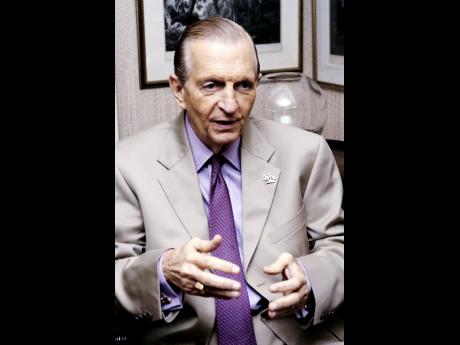Three-part documentary on Seaga launched
A THREE-PART, roughly two-hour-long audio-visual documentary on the life and work of former prime minister, The Most Honourable Edward Seaga, was recently launched at King’s House. In attendance were Governor General Sir Patrick and Lady Allen, religious, political and academic VIPs, as well as many other Jamaicans.
Funded by the Culture, Health, Arts, Sports and Education (CHASE) fund and produced by the Creative Production and Training Centre (CPTC), the documentary, Edward Seaga: From Rebel to Leader, is generally laudatory about the man repeatedly called “a nation builder”. Still, the praise is tempered by the comments from historians and those of a different political persuasion from the former JLP leader. The latter include Prime Minister Portia Simpson Miller, former prime minister P.J. Patterson and the late PNP government ministers Dudley Thompson and David Coore.
Narrated by actressbroadcaster Leonie Forbes, the video covers even more than the 40-odd years of Seaga’s political life. It goes back to his days as a Harvard University student and the start of his anthropological research in Buxton Town. Comments come from residents of the community about the fear many had of the “white man” who had come to live with them and question them about aspects of their lives.
He was initially thought to be a “black-heart man”, who killed children and ate their hearts, but he was later accepted wholeheartedly. Seaga talks of how he learnt about the “world of spirits” and how the knowledge changed him “forever”.
Subsequently, he went to Salt Lane, near Coronation Market, where he delved further into that world through research on Revival. His encounter with the music of that sect was followed by interest and participation in the production of Jamaican popular music, notably ska.
In 1959, Seaga acceded to the JLP request that he join the party and he entered the Independence period three years later with, he said, “high expectations”. He became minister of development and welfare, wanting to help strengthen the influence of Jamaica’s culture. Among other things, under Seaga’s leadership, the Jamaica Festival (forerunner to the JCDC) began and Marcus Garvey’s remains were repatriated and the man named the island’s first national hero. Devon House was also restored.
Seaga’s role in the development of culture generally – including folk religion (Revival and Kumina), sports, dance, music, and painting and sculpture (through his relationship with Kapo and other artists) – is examined.
The documentary covers not only Seaga’s public life, but his personal life, too, often poignantly. It shows Seaga’s first wife, Marie ‘Mitsy’ Seaga, telling how they met, how shy he was and how she asked him for their first dance, to a ska tune.
The current Mrs Seaga, Carla, dismisses the myth that her husband is “uncaring”. Seaga gives as a reason for the break-up of his marriage to ‘Mitsy’, the fact that he devoted himself to his work “24/7” and neglected his family in terms of time spent with them. Three of Seaga’s four children – Christopher, Andrew, and Anabella – appear in the video. His youngest child, the audience heard, recently started grade seven. Seaga’s leadership in the establishment of Tivoli Gardens, on the slum land known as Dungle, is among the many outstanding sociopolitical achievements recorded in the video. Later, the killing of Tivoli residents by the police during an incursion July 4-7, 2001, Seaga said, made him “very, very angry” and left him permanently “embittered” by the event.
The video documents Seaga’s many other political achievements during his tenure in the Cabinet, in his various ministerial positions and as prime minister. They begin with his speech in the Legislative Council, “on the haves and the have nots,” to quote an admiring Patterson, which “created a template for new dialogue”. Seaga himself said of the speech, “It shook up the country”.
Other achievements are: the development of the Kingston waterfront, the set-up in 1968 of the Urban Development Corporation, the development of Ocho Rios and Negril as tourists centres, the facilitation of ownership by Jamaicans in banks and the life-insurance industry, and the establishment of the Montego Bay Free Zone and the HEART programme.
Seaga also won nine consecutive elections in his West Kingston constituency and was the longest serving MP. He left Parliament in 2005 to resume life as an academic, as a Fellow at the University of the West Indies. He later became a Chancellor of the University of Technology.
The documentary leaves the viewer convinced that its subject is indeed a “complex man”. For example, he has been called both “cold” and “fiery”, both “caring” and “unfeeling”. Before the showing, Seaga made a brief thank-you statement, while CPTC Chairman Christopher Samuda and CHASE director Fae Ellington commented on the role of their organisations in the making of the documentary. From Ellington, the audience learnt that CHASE has spent some $132 million on the implementation of similar projects. The invocation was made by Bishop Herro Blair, and master of ceremonies was Paula-Ann Porter-Jones.

